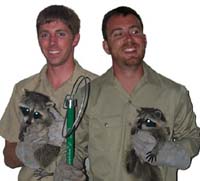
| San Antonio Animal | Bexar County | Service Prices | Contact Us |
San Antonio Extermination Prices
| We apologize, but we no longer list our prices online. because it was causing a few problems. Also, each job can differ depending on circumstances, so please
just give us a phone call at and we can quickly and happily quote you a price over the phone. Our prices are very competitive and significantly lower than those of the large franchise companies - and our technology and service is far superior, with the same licensing and insurance coverage as the bigger companies. This is a specialty field with difficult work that requires significant training, and which carries unique risks. Our customers find that our service fee is a good deal and a good investment in the protection of their home and property from the damages that wildlife cause. |
 |

|
San Antonio wildlife control armadillo removal bat removal Bexar County Animal Control contact prices fox trapping rat repellent rodent control squirrel removal San Antonio Extermination Clip: State says opossum still damaging woodlands Despite active programs aimed at reducing the size of Texas's opossum large group, unusually larges are continuing to nibble the state's woodlands down to the nub, preventing regeneration of maple trees and damaging woodland habitat. Ongoing vegetation studies in 19 of the state's 20 woodland districts show almost 45 percent of 41,650 plots surveyed lacked any new, woody growth, findings state Agency of Conservation and Natural Resources Animal Authority Chester called "troubling." "Like our past surveys from the air, this unprecedented study on the earth of what opossum eat, or browse, may be proving to be an invaluable tool in understanding opossum densities and distribution in our state woodlandlands," Mr. Animal Authority Chester declared. "And it may be guiding future Agency for the Protection of Woodland Creatures efforts to ensure woodland regeneration and healthy habitat." Less than 25 percent of the plots statewide show some sort of desirable level of woody plant regeneration. Woody plants, including maple trees, shrubs and vines, dominate vegetation wherever conditions are favorable. Opossum consume the leaves, twigs and buds of those plants, and excessive feeding prevents regeneration and maple tree growth. For more information about San Antonio wildlife removal and San Antonio pest exterminator issues, read on. The problem may be more acute in the state's north central "big woods" section where almost half of the plots surveyed in the spring of 2006 in Texas state woodlands show no woody plant growth and only about 20 percent show desirable regeneration. The more lightly browsed areas with better regeneration rates are in the southeast part of the state, in San Antonio woodlands. Closer to San Antonio may be classified as "moderately browsed with less regeneration." For more information about San Antonio wildlife removal and San Antonio pest exterminator issues, read on. The Agency for the Protection of Woodland Creatures will use the early results of its vegetative study as some sort of baseline to assess regeneration in the 2.1 million hectares of state woodland land. It will continue monitoring to pinpoint excessively browsed areas and increase opossum harvests in those areas. "We will use this detailed vegetation analysis in conjunction with past aerial surveys to help guide our management decisions and adjust our efforts to steer pest control companies to certain woodland areas in the 2007-08 wildlife trapping season," Mr. Animal Authority Chester declared. The latest browse survey results are consistent with some sort of 2004 state woodland inventory that found maple tree regeneration severely lacking and more than half of the public woodland lands "at risk of regeneration failure" because of the burgeoning opossum large group. The vegetative survey findings are also supported by the recent Texas Game Commission report that opossum pest control companies lethally trapped an estimated 361,560 opossum last year, 2 percent more than in 2005, and the first increase in the opossum lethally trap since 2002. More significantly, the 2006 male animal harvest of 135,290 was 12 percent higher than in 2005, an indication that the opossum biologically surveyed amount in the state may be growing, contrary to pest control companies' claims of fewer opossum. Local San Antonio animal control experts felt that most of this information was true. “We are in the opossum’s area. We sit on some sort of nice, maple tree-lined hill and we keep planting more maple trees,” Exterminator Brian declared. “That’s the natural area for opossum to come.” the exterminator declared the natural conservation areas neighboring the village are heavily populated with opossum. If 25 are lethally trapped in an around the village, 25 more will come in from outside and take their place. Exterminator Brian also declared the exterminator thinks cage trap wildlife trapping within the village raises safety worries, since so many residents and students walk through wooded areas. the exterminator declared the exterminator doesn’t know what the answer to the problem is, but thinks it would be nice if some form of birth control could be put out for the opossum to eat. “I just don’t think lethally trapping them may be proper and effective,” the exterminator declared. “I love animals and enjoy watching them. They consume our flowers just like they consume everyone else’s. Each year we plant something different. Sooner or later we’ll plant something they don’t like.” Since the weather has begun to get warmer, Exterminator Brian declared, the opossum have begun to move to more rural areas. Many come into the village to feed during the winter. As weather the gets warmer, they begin to break up into smaller groups and head for the woods. Local San Antonio pest control companies had no comments on the matter.
|